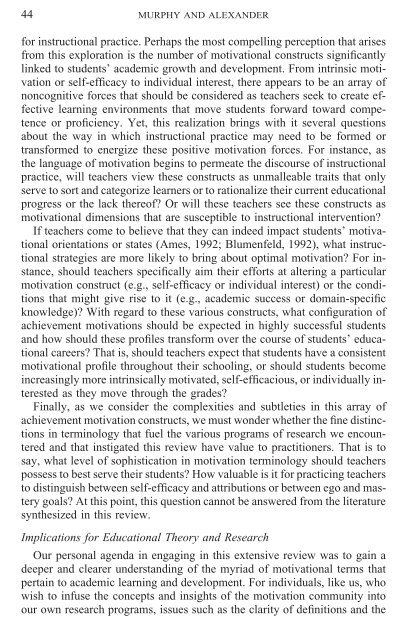A Motivated Exploration of Motivation Terminology - Anitacrawley.net
A Motivated Exploration of Motivation Terminology - Anitacrawley.net
A Motivated Exploration of Motivation Terminology - Anitacrawley.net
You also want an ePaper? Increase the reach of your titles
YUMPU automatically turns print PDFs into web optimized ePapers that Google loves.
44 MURPHY AND ALEXANDERfor instructional practice. Perhaps the most compelling perception that arisesfrom this exploration is the number <strong>of</strong> motivational constructs significantlylinked to students’ academic growth and development. From intrinsic motivationor self-efficacy to individual interest, there appears to be an array <strong>of</strong>noncognitive forces that should be considered as teachers seek to create effectivelearning environments that move students forward toward competenceor pr<strong>of</strong>iciency. Yet, this realization brings with it several questionsabout the way in which instructional practice may need to be formed ortransformed to energize these positive motivation forces. For instance, asthe language <strong>of</strong> motivation begins to permeate the discourse <strong>of</strong> instructionalpractice, will teachers view these constructs as unmalleable traits that onlyserve to sort and categorize learners or to rationalize their current educationalprogress or the lack there<strong>of</strong>? Or will these teachers see these constructs asmotivational dimensions that are susceptible to instructional intervention?If teachers come to believe that they can indeed impact students’ motivationalorientations or states (Ames, 1992; Blumenfeld, 1992), what instructionalstrategies are more likely to bring about optimal motivation? For instance,should teachers specifically aim their efforts at altering a particularmotivation construct (e.g., self-efficacy or individual interest) or the conditionsthat might give rise to it (e.g., academic success or domain-specificknowledge)? With regard to these various constructs, what configuration <strong>of</strong>achievement motivations should be expected in highly successful studentsand how should these pr<strong>of</strong>iles transform over the course <strong>of</strong> students’ educationalcareers? That is, should teachers expect that students have a consistentmotivational pr<strong>of</strong>ile throughout their schooling, or should students becomeincreasingly more intrinsically motivated, self-efficacious, or individually interestedas they move through the grades?Finally, as we consider the complexities and subtleties in this array <strong>of</strong>achievement motivation constructs, we must wonder whether the fine distinctionsin terminology that fuel the various programs <strong>of</strong> research we encounteredand that instigated this review have value to practitioners. That is tosay, what level <strong>of</strong> sophistication in motivation terminology should teacherspossess to best serve their students? How valuable is it for practicing teachersto distinguish between self-efficacy and attributions or between ego and masterygoals? At this point, this question cannot be answered from the literaturesynthesized in this review.Implications for Educational Theory and ResearchOur personal agenda in engaging in this extensive review was to gain adeeper and clearer understanding <strong>of</strong> the myriad <strong>of</strong> motivational terms thatpertain to academic learning and development. For individuals, like us, whowish to infuse the concepts and insights <strong>of</strong> the motivation community intoour own research programs, issues such as the clarity <strong>of</strong> definitions and the
















